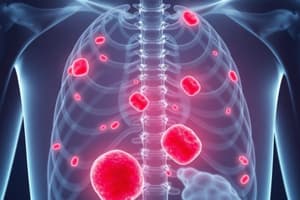Podcast
Questions and Answers
What primarily causes constant random failures in bones?
What primarily causes constant random failures in bones?
- Aging
- Trauma and acute diseases (correct)
- Manufacturing errors
- Congenital disorders
What is a key characteristic of the diaphysis in bone structure?
What is a key characteristic of the diaphysis in bone structure?
- It has a spongy structure for weight distribution.
- It serves as a lever for muscle movement. (correct)
- It contains densely packed trabecular bone.
- It is primarily responsible for calcium storage.
Which part of the bone structure is designed to support the articular surface?
Which part of the bone structure is designed to support the articular surface?
- Bone marrow
- Metaphysis (correct)
- Cortex
- Diaphysis
Which type of failure is exemplified by osteoporosis and osteoarthritis?
Which type of failure is exemplified by osteoporosis and osteoarthritis?
What feature of the metaphysis and epiphysis helps in evenly transferring weight through the bone?
What feature of the metaphysis and epiphysis helps in evenly transferring weight through the bone?
Flashcards
Bone Failure Modes
Bone Failure Modes
Bones can fail due to manufacturing errors (developmental issues), sudden trauma (accidents or infections), or wear-and-tear (like arthritis).
Diaphysis Function
Diaphysis Function
The diaphysis (shaft of a long bone) acts like a lever, increasing muscle power for movement at joints.
Metaphysis/Epiphysis Structure
Metaphysis/Epiphysis Structure
The metaphysis and epiphysis (ends of a long bone) have a reduced need for bending strength and thus use thinner cortices and spongy bone.
Bone Remodeling
Bone Remodeling
Signup and view all the flashcards
Calcium Homeostasis
Calcium Homeostasis
Signup and view all the flashcards
Study Notes
Modes of Failure
- Manufacturing errors: Disorders of formation and growth, impacting primarily pediatric patients.
- Constant random failures: Primarily due to trauma, infection, cancer, or other acute diseases.
- Wearout failures: Progressive wear of parts, leading to conditions like osteoporosis, osteoarthritis, and rheumatoid arthritis.
Bone Structure
- Diaphysis: Acts as a lever for increased muscle power; characterized by thick cortices.
- Metaphysis and Epiphysis: Have reduced bending force, resulting in thinner cortices and spongy trabecular bone; support articular surfaces, absorb impact, and distribute weight evenly.
Studying That Suits You
Use AI to generate personalized quizzes and flashcards to suit your learning preferences.
Related Documents
Description
Test your knowledge on the various modes of bone failure, including manufacturing errors and wearout failures, as well as the structural components of bones. This quiz will cover key aspects of bone anatomy and the implications of different types of failures on pediatric and adult patients. Assess your understanding of how bone structure supports function and impact resistance.




